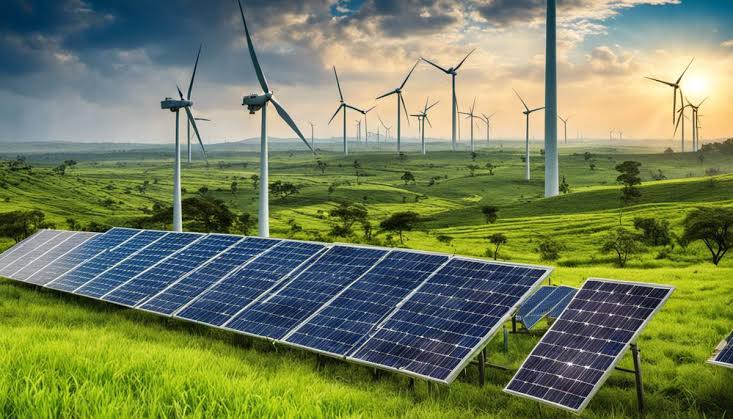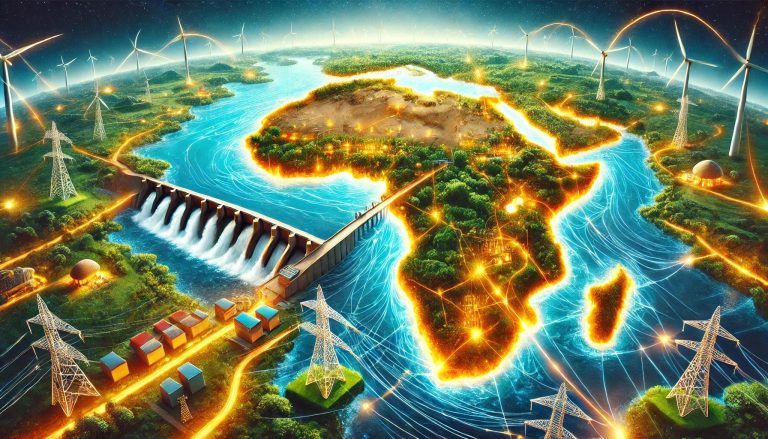
Africa’s Renewable Energy Transition Amidst Debt Crises
The global climate crisis has brought sustainability to the forefront of policy conversations, and these have particularly focused on the energy transition. The energy transition requires financing, and this has presented issues in African countries, given the growing debt crises throughout the continent.
Debt Crises in Africa
Since 2010, the total debt in Africa has increased by 183%, largely due to external shocks such as COVD-19 and the war in Ukraine (UNCTAD, 2023). In 2022, 24 African countries had a debt to GDP ratio greater than the 60% threshold for sustainability (ibid). The lending landscape has also changed in recent years; 44% of African debt is owed to private creditors, and there is less coordination between these creditors (ibid). The debt crisis has devastating consequences; over 50% of African countries spend more on debt servicing that they do on public health, impeding development (Kenewendo & Njoroge, 2024). Similarly, overall debt in Africa has been increasing at a higher rate than that of GDP growth (UNCTAD, 2023).
Climate Risk
In the face of growing debt crises, African countries also must combat climate change and invest in adaptation mechanisms. To date, Africa has only produced 3% of global CO₂ emissions, yet the continent is already facing the worst effects of climate change (IEA, 2022). Decreases in rainfall will affect agricultural sectors, increasing food scarcity and food prices (Asafu-Adjaye, 2023). If global temperature rises are not mitigated, desertification and low availability of water will affect large amounts of people, particularly in North Africa (IRENA, 2023). Climate effects will also impact national GDPs, predicted to begin decreasing at a 0.7℃ increase in temperature (ibid).
Simultaneously energy poverty is rampant, as 80% of people in the world without access to electricity reside in Africa (Ighobor, 2024). Currently, 140 million people in the Horn of Africa do not have electricity (IEA, 2022). Thus, developmental goals call for expanded electricity access, which may increase emissions (Dimnwobi et al., 2023). Yet current consequences of a lack of electricity produce greenhouse gas (GHG) emissions, as those without electricity opt for cheap and unsafe cooking fuels, such as fossil fuels (ibid). These issues have driven the concept of a “Just Energy Transition,” which focuses on clean energies, but also on expanding the electrical grids and infrastructure, putting the people at the forefront of the energy transition (Asafu-Adjaye, 2023). However, such initiatives require funding.
Climate and Funding
Climate change effects on Africa will increase in the future, requiring more government spending on adaptation and renewable energy initiatives. This necessitates funding and large-scale debt relief (Kenewendo & Njoroge, 2024). Lenders must consider climate factors, instead of just the country’s ability to service its debts (ibid), as these will certainly affect the country’s ability to service its debts. Thus, there is a need for mechanisms to incorporate the risks accompanying climate change (i.e. governments must spend higher on climate adaptation), and the opportunities in climate initiatives (natural gas markets, etc.), into loans.
Climate Development Aid
Recent conversations have highlighted a new mechanism for African countries to receive climate finance: climate reparations (Lenferna, 2023). At COP27, South Africa demanded these be provided by Western countries, to account for their historically high levels of pollution and current (and future) devastating environmental effects experienced in Africa (ibid). The African continent has large carbon sinks – areas that absorb more carbon dioxide than they release – which have played a large role in offsetting global emissions, most notably the Congo basin (UNECA, 2023). Thus, climate reparations can be justified on the grounds of the continent’s low contributions towards total global emissions, and its high contributions towards absorbing global emissions. However, climate reparations are dependent on political will, which has not yet shifted in favor of such payments; in 2023 the United States announced that it refuses to pay countries in the Global South suffering from climate-linked natural disasters (Slow, 2023).
Climate policy has become an important component of development aid, especially as countries in the Global North – previously large polluters – begin to shift towards green technologies (von Lüpke, 2023). As this change occurs, and as essential access to electricity increases in poor countries, it becomes likely that nations in the Global South will release more GHG emissions than their northern counterparts (ibid). In Africa, debt crises and infrastructure gaps contribute towards a large funding gap for the energy transition. Proposed solutions include: “debt-for-climate swaps, sustainability-linked bonds, and climate-linked debt” (Archibong & Osafo-Kwaako, 2023). Particularly attractive are “debt-for-climate swaps,” which allow debt relief, so long as countries utilise debt servicing savings to invest in climate projects (ibid).
Profitability of the Energy Transition
The energy transition in Africa will certainly require aid, however there is also space for market-based solutions through private investment. Currently, Africa holds 40% of the world’s cobalt, manganese, and platinum reserves, and it is likely that countries have further undiscovered reserves (IEA, 2022). These play a significant role in green technologies, such as hydrogen technologies and batteries (ibid). Creating the infrastructure to export these materials will certainly be profitable, as demand for transition materials increases. Already, 42% of African countries have enacted restrictions on the raw materials exports, leading mining companies to set up local processing plants, thus increasing employment opportunities (Osinbajo, 2024). Similarly, Africa contains vast clean energy resources which widely remain untapped, such as solar, wind and hydropower (Moses, 2023). East African governments have enacted policies to encourage investment in profitable renewable energy industries (i.e. tax incentives), however investment remains low (R4A). In fact, the continent currently has 60% of global solar resources, and “uses only 11 percent of its hydropower potential and 0.01 percent of its wind potential” (ibid). Investment into the energy transition will also benefit communities, as this transition will create employment opportunities; an estimated 4 million new jobs will be needed by 2030 (IEA, 2022). Investment in such areas therefore will not only benefit the continent, but will also have global benefits. Yet only 5% of energy investments are presently directed towards Africa (ibid).
South Africa
A continental leader in the energy transition, South Africa has made headways in its Just Transition through large projects. The country’ struggles from its coal dependence, and as such, this area has been its primary focus (Winkler et al., 2023). Though renewable energies are now cheaper than coal, a transition to these requires infrastructure and financing (ibid). In 2020, South Africa created the Just Energy Transition Office in its state-owned electricity enterprise Eskom, aimed towards facilitating a transition away from coal and towards clean energy, while simultaneously expanding national electricity access (ibid). At the 26th UN Climate Change Conference in 2021, South Africa entered into the first Just Energy Transition Partnership (JETP) in which an International Partners Group (IPG) committed 8.5 billion USD towards the country’s energy transition to be delivered in 3-5 years (von Lüpke, 2023). This funding is mainly loans, provided by a small group of donor countries – France, Germany, the United Kingdom, the United States, and the European Union (ibid). Though a step forward, it is important to note that since only a few countries are contributing towards this JETP, it is likely that South Africa will need to meet donor demands attached to these loans (ibid). Yet, as the largest coal producer in Africa, a shift away from coal and towards renewable energy in South Africa promises high climate rewards (Mirzania, 2023).
Nigeria
In Nigeria, 45% of the population does not have access to electricity, calling for a just transition in its shift towards renewables (Archibong & Osafo-Kwaako, 2023). The country will not be uniformly impacted by climate change; its northern areas will be most affected, particularly through decreased rainfall (ibid). Thus, a “just transition” will also necessitate that the government account for unequally dispersed climate change effects, and invest more into climate adaptation in its northern regions. Once again, funding gaps play a large role in hindering Nigeria’s transition. The 2022 “Nigeria Energy Transition Plan (ETP)” appears promising in its target of a carbon neutral Nigeria by 2060 (Archibong & Osafo-Kwaako, 2023). This ETP will increase energy access, reduce use of dangerous and high-emission cooking fuels, deploy climate-smart agriculture (CSA), and create jobs (ibid). However, this plan requires approximately 410 billion USD in financing, a number that cannot be achieved solely utilising the country’s capital investment budget (ibid).
Furthermore, Nigeria is heavily dependent on oil for government revenue, and demand for oil is predicted to drop due to the global energy transition (Archibong & Osafo-Kwaako, 2023). In fact, the country’s top five clients for petroleum products – the United States, Netherlands, Spain, India, and China – have all announced commitments to carbon neutrality, between 2030 and 2050 (Chinery & George-Ikoli, 2022). Such drastic predicted losses in oil revenue will significantly drop Nigeria’s government revenue, and as a result, its capacity to fund climate projects. It seems that the government plans to shift towards natural gas exports to account for future revenue losses, however this transition will be lengthy and costly (ibid). The future of Nigeria’s Just Transition will therefore require increased funding and economic diversification.
Regional Comparisons: Latin America & Caribbean and South Asia
South Asia faces high climate threats, as it is one of the areas of the world that will be hit the hardest by climate change (Fruman & Gupta, 2023). Simultaneously, it is developing at a high rate, leading to increased energy demands (ibid). Recent reports state that Southeast Asian demand for electricity will grow at an estimated 4% each year, indicating a need for renewables to meet this demand (IEA, 2024). Electricity use increases are driven by expanded electrical access, yet they are also driven by environmental factors; climate-change causes heat waves have increased air conditioner use (ibid). Positively, current trends show that clean energy will be able to meet around ⅓ of increased electricity demands, however interventions must scale up for a sustainable future (ibid). Such projects are dependent on funding, yet the region only receives 2% of green energy investments (ibid).
Compared to Africa and South Asia, Latin American and the Caribbean (LAC) appears to face less pressing issues in the energy transition. In fact, the electricity sector in this region is the cleanest in the world (IEA, 2023), as it heavily utilises hydropower, as well as solar and wind energy (Mehlum, 2024). Similar to Africa, the LAC region has the capacity to profit heavily in the energy transition due to its abundance of natural resources (IEA, 2023). This includes wind, solar, and hydropower, as well as natural gases and raw minerals needed in green technologies (ibid). However, progress has stagnated in the last decade, and Latin America’s growth in energy transition initiatives is the slowest in the world, seeing a “70% decline in investment in renewables” (Mehlum, 2024). Conversations on the LAC region highlight a need for policy solutions to expedite LAC’s energy transition, and to allow for the region to capitaliseon its natural resources in the transition (IEA, 2023).
Conclusions
As the political will and international cooperation increase for the energy transition, it is essential for Africa to be at the forefront of these conversations, particularly in funding considerations. The continent bears the least responsibility for, yet the highest effects of climate change. Given the current debt crises plaguing the continent, largely driven by external shocks, there is a need for funding for green technologies in Africa. Funding can come from development aid, from debt-for-climate swaps, from climate reparations, and from private investors. Given the profitability of the climate sector, investing in Africa is certainly a lucrative opportunity, which remains largely untapped. Debt servicing costs have increased in unsustainable amounts in the last decade, as have climate effects, therefore it is necessary to ramp up energy transition efforts for a sustainable future.
Annette Sorensen is a Fellow at the Sixteenth Council.



